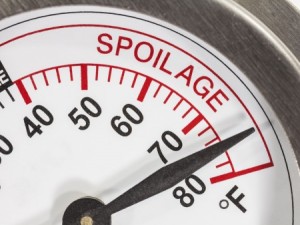Chow Line: Tips to prevent food spoilage when the power goes out

Take care with food during power outages. Submitted photo.

Storm preparedness has been on my mind lately. I’m wondering what I can do to be ready in the event of a power outage to prevent the foods in my refrigerator from spoiling?
One of the biggest factors in deciding whether the foods in your household will spoil during a power outage is the duration of the power loss. Generally speaking, perishable foods that have been in temperatures above 40 degrees for two hours or more will need to be discarded to avoid the potential for food borne illnesses.
While you cannot control the duration of a power outage (unless you use a generator) there are some steps that you can take before the storm to prepare in the event that your power goes out. One way is to make sure that you have on hand a few day’s worth of ready-to-eat foods that do not require cooking or cooling, says the U.S. Department of Agriculture Food Safety and Inspection Service. This does not exclude places such as restaurants, that may have to deal with similar scenarios, or wait for a commercial refrigerator repair service if any of their equipment should fail, thus affecting their business. If you often experience power outages, and you aren’t in an area that is prone to extreme weather, there might be a problem with your residential electricity supply. You should contact a local electrician like Safe and Sound Electric to resolve these issues. Click to find out more about Safe and Sound Electric, and how you can help protect your foods from spoiling in the long term.
Whilst waiting to resolve your electrical issues, it would be best not to buy fresh produce that requires colder temperatures. Foods such as meat, dairy products, and any frozen items should be avoided and cupboard items should be prioritized. Examples include shelf-stable foods, boxed or canned milk, water, and canned goods. Also, it is a good idea to have ready-to-use baby formula for infants on hand and foods for your pet available.
In addition, know where you can purchase dry ice or block ice, and make sure you have coolers on hand that you can use to temporarily keep refrigerator food cold if the power goes out for more than four hours. A 50-pound cake of dry ice should protect the food in a full, 20-cubic-foot freezer for three to four days, according to an Ohio State University Extension Ohioline fact sheet.
Be careful, however, when using dry ice to avoid the build up of gas. To prevent gas buildup, don’t use dry ice in a closed or unvented container. To relieve gas pressure in your refrigerator or freezer, open the door occasionally. And always wrap the dry ice in a towel or newspaper prior to use, being careful not to touch the dry ice with your bare hands, Ohioline advises.
Other tips from USDA and Ohioline to be prepared for a power outage before the storm include:
- Keeping appliance thermometers in both the refrigerator and the freezer to ensure temperatures remain food safe during a power outage. Safe temperatures are 40 degrees or lower in the refrigerator, 0 degrees or lower in the freezer.
- Place two or three ice cubes in a plastic freezer bag and seal the bag. Keep the bag in the freezer at all times. In an upright freezer, you can have a test bag on each shelf. If there is a power outage, you will know if the interior temperature was above 32 degrees if the cubes melt.
- Freeze water in one-quart plastic storage bags or small containers prior to a storm that can be used to fit around the food in the refrigerator and freezer to help keep food cold.
- Freeze refrigerated items, such as leftovers, milk and fresh meat and poultry that you may not need immediately-this helps keep them at a safe temperature longer.
- Group foods together in the freezer to help the food stay cold longer.
Once the power goes out, Ohioline recommends that you keep the refrigerator and freezer doors closed as much as possible. This is because a refrigerator will keep food cold for about four hours if the door is kept closed, and a full freezer will hold its temperature for about 48 hours. A half-full freezer will hold its temperature for 24 hours if the door is kept closed.
Once your power is back on, it is important that you check your food to make sure it is safe to eat. Generally, you should throw away any perishable food that has been above 40 degrees for more than two hours. Remember, never taste food to determine its safety.
Additional information on food safety before, during and after a power outage can be found on the Ohioline website at ohioline.osu.edu/factsheet/HYG-5357.
Chow Line is a service of the College of Food, Agricultural, and Environmental Sciences and its outreach and research arms, OSU Extension and the Ohio Agricultural Research and Development Center. Send questions to Chow Line, c/o Tracy Turner, 364 W. Lane Ave., Suite B120, Columbus, OH 43201, or [email protected].









